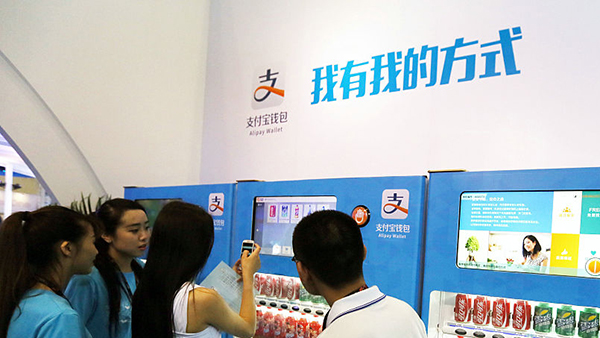(单词翻译:单击)
In the early 1980s, people in China had a one-stop shop for all their banking needs: the People’s Bank of China.
在上世纪80年代初的中国,人们的所有银行需求都可以“一站式”解决:中国人民银行(PBoC)。
It was, in fact, the only bank in China at the time, as well as the central bank. During the early years of economic reform in the country, citizens, government-owned enterprises and the first green shoots of private business had little choice about who to bank with. Marketing and branding for the state monopoly was virtually nonexistent.
实际上,当时它是中国唯一的银行,也是央行。在中国实行经济改革的头几年里,公民、政府所有的企业以及刚兴起的第一批民营企业对于去哪家银行办理业务几乎毫无选择。对于这家政府垄断企业而言,市场营销和品牌建设之类的活动基本不存在。
More than three decades later, branding for banks in China has taken on new urgency.
30多年后,中国银行业在品牌建设方面呈现出了新的紧迫感。
The banking sector has opened up, adding thousands of new institutions. Choice has proliferated for consumers. Speed, efficiency and convenience in financial services has fashioned new household names, mainly for the internet companies that have experimented in finance.
银行业已经开放了,出现了数千家新的金融机构。消费者的选择大为增多。金融服务的速度、效率和便利性塑造出了许多家喻户晓的新品牌,主要是那些试水金融业的互联网公司。

Meanwhile, the brands of powerful state banks are in an early stage of decline.
与此同时,对于实力雄厚的国有银行来说,它们的品牌已然步入衰落期的初步阶段。
“Beyond the bank’s traditional image, another important thing is convenience,” says Yang Cao, chief operating officer at Yirendai, one of China’s largest peer-to-peer lenders and one of the institutions competing head on with banks. “Younger consumers value convenience a lot. They will look at how convenient your mobile app looks and they pick the bank because of that.”
“除了银行的传统形象之外,另一个重要因素是便利性,”宜人贷(Yirendai)首席运营官曹阳表示,“较年轻的消费者非常重视便利性。他们会看你的手机app有多方便,他们会因此选择银行。”宜人贷是中国最大的P2P贷款机构之一,也是与银行展开正面竞争的金融机构之一。
The 2017 BrandZ Top 100 Most Valuable Global Brands ranking shows China’s top four state-owned banks losing ground in 2017. Bank of China, the oldest and most international of the four, tumbled 23 rankings to 94th, while Agricultural Bank of China fell 10 places to 72nd.
在BrandZ 2017年“全球最具价值品牌百强榜”(Top 100 Most Valuable Global Brands)上,中国四大国有银行的排名均出现下滑。历史最悠久、国际化程度最高的中国银行(Bank of China)下滑23位,位列第94,中国农业银行(Agricultural Bank of China)下滑10个位置,排在第72位。
China Construction Bank fared slightly better, losing eight positions to 54. Industrial and Commercial Bank of China, one of the world’s largest banks by market capitalisation, fell one place to 28th, retaining its position over global competitors such as Citi, JPMorgan and ANZ. The four Chinese banks did not respond to requests to comment on the fall in ranking.
中国建设银行(China Construction Bank)表现略好,下滑8个位置,排在第54位。全球市值最高的银行之一中国工商银行(ICBC)下跌一位,排在第28,继续领先于花旗(Citi)、摩根大通(JPMorgan)和澳新银行(ANZ)等全球竞争对手。对于记者提出的就排名下滑置评的请求,中国四大国有银行均未回应。
By comparison, Tencent, an internet group that launched one of China’s first privately owned banks in 2014, is ranked eighth in global brand recognition, climbing three places in 2017 and trumping the likes of IBM. Alibaba, an ecommerce company that now runs the world’s largest money market fund, rose four places to 14th.
相比之下,互联网集团腾讯(Tencent)排名第八,上升3个位置,超过IBM等公司。腾讯在2014年推出的银行是中国首批民营银行之一。电商集团阿里巴巴(Alibaba)上升4位,排在第14,该集团管理着全球最大的货币市场基金。
Banks are late to the branding game because they have focused mainly on servicing state-owned companies, experts say, often ignoring the rapidly building wealth of Chinese people around them. In sharp contrast, companies such as Tencent and Alibaba founded their businesses on directly serving customers over the internet and have been much more in touch with the financial needs of ordinary people.
专家们表示,银行很晚才开展品牌建设活动,因为它们主要专注于为国有企业服务,往往忽视了周围的普通人已快速累积起财富。与它们形成鲜明对比的是,腾讯和阿里巴巴等公司的业务基于直接通过互联网为客户服务,与普通人的金融需求有更多的接触。
Alibaba, for example, founded Alipay, an online payment service, in 2004. State companies such as China UnionPay followed that lead more than a decade later in December 2015. Alibaba’s Yu’e Bao became the world’s largest money market fund in March when its assets under management hit $165bn, a testament to how non-financial companies have enjoyed the same trust as banks.
例如,2004年,阿里巴巴推出了在线支付服务支付宝(Alipay)。国有企业则晚了十多年,中国银联(China UnionPay)直到2015年12月才推出在线支付服务。今年3月,阿里巴巴的“余额宝”成为全球最大的货币市场基金,其管理的资产总额达到1650亿美元,证明非金融公司也能像银行一样获得信任。
“China’s financial services [sector] in the past was focused on services for corporations. But over the past 30 years, the personal wealth of ordinary Chinese people and retail financial services have increased dramatically,” says Richard Sheng, brand director for Ping An Group. He reels off a number of services that banks and insurance companies have deployed over the past decade with the hope of catching the eye of consumers, such as credit cards and new types of insurance products.
中国平安(Ping An Group)品牌总监盛瑞生(Richard Sheng)表示:“在过去,中国金融服务(行业)专注于为公司服务。但过去30年来,普通中国人的个人财富显著增长,零售金融服务也大有发展。”他历数了过去十年中银行和保险公司为吸引消费者眼球而推出的许多服务,例如信用卡和新型保险产品。
“This is all part of the effort to serve more and more consumers?.?.?.?It shows how the brand of the business has become more and more important,” Mr Sheng added.
盛瑞生补充称:“这些都是为了服务于越来越多的消费者……这表明,企业的品牌已变得越来越重要。”
Ping An Insurance ranks 61st, making it the world’s top insurance brand due to its modest increase in size over the past year, its enormous network of agents and its extensive product offering. As a large financial service provider, with banking and asset management units, it has invested heavily in technology and now runs Lufax, China’s largest online wealth management group, with Rmb438bn in assets under management from retail customers at the end of 2016.
平安保险(Ping An Insurance)位列第61,因其过去一年在规模上小幅增长、拥有庞大的保险代理人网络以及多样的产品而成为全球排名第一的保险品牌。作为一家兼有银行业务和资产管理业务的大型金融服务提供商,平安在技术方面大举投资,并且运营着中国最大的网上理财公司陆金所(Lufax)。截至2016年底,陆金所为零售客户管理着4380亿元人民币的资产。
Peer-to Peer (P2P) lending, where retail investors are connected with borrowers via an online platform, has also started to make off with a significant chunk of capital from the formal banking system. The loan balance for P2P lending in May hit Rmb996bn ($146bn), up from only Rmb184bn two years earlier, according to industry consultant WDZJ.com.
P2P网贷平台——为零售投资者与借贷者牵线搭桥的在线平台——也开始从正规银行系统吸走大量资本。据行业咨询公司网贷之家(WDZJ.com)表示,5月P2P贷款余额达到9960亿元人民币(合1460亿美元),而两年前仅为1840亿元人民币。
Banks have not taken these losses to their capital base lying down, says Richard Cao, an analyst at Chinese securities house Guotai Junan in Shenzhen
中国券商国泰君安的深圳分析师曹柱(Richard Cao)称,银行并未坐视自己的资本基础被削弱。
“In order to face up to the competition, they have been launching all sorts of new operations, like their own P2P businesses,” he says. ICBC, for example, has started its own P2P platform and has an online shopping network that has mimicked Alibaba’s service. It claimed in its 2016 annual report that 250m people use its mobile application.
“为了应对竞争,它们开展了各种新业务,比如它们自己的P2P业务,”曹柱表示。例如,中国工商银行开通了自己的P2P平台,并拥有效仿阿里巴巴服务的在线购物平台。它在2016年度报告中声称,有2.5亿人使用其手机app。
The state banks could be losing some ground to internet finance rivals, Mr Cao says, but they still have much greater visibility compared with most other companies because of their vast branch networks. Agricultural Bank of China alone, for example, had 23,682 branches across the country by the end of last year, making it one of the most visible banks in the world.
曹柱称,相对于互联网金融公司,国有银行或许失去了一些优势,但由于它们庞大的分支网络,与多数其他公司相比,它们的品牌知名度还是要大得多。例如,截止去年年底,单单中国农业银行在全国就拥有23682家支行,使其成为全球知名度最大的银行之一。
In some respects, branding for the state banks may not have changed much from the early days of reform. The government-controlled lenders are still focused on corporate business, with corporate deposits still outweighing those from retail depositors.
在某些方面,与改革初期相比,国有银行在品牌推广方面可能没有多少变化。由政府控制的银行仍然注重企业业务,企业存款仍然超过零售储户存款。
“The branding is important for the retail business,” said Jonathan Koh, an analyst at UOB Kay Hian, a Singaporean broker. “But corporate banking, this is still a relationship-based business. Branding will not change it much.”
“品牌推广对于零售业务十分重要,”新加坡券商大华继显(UOB Kay Hian)的分析师乔纳森?科赫(Jonathan Koh)表示,“但企业银行业务仍然以关系为基础。品牌不会有太大影响。”


